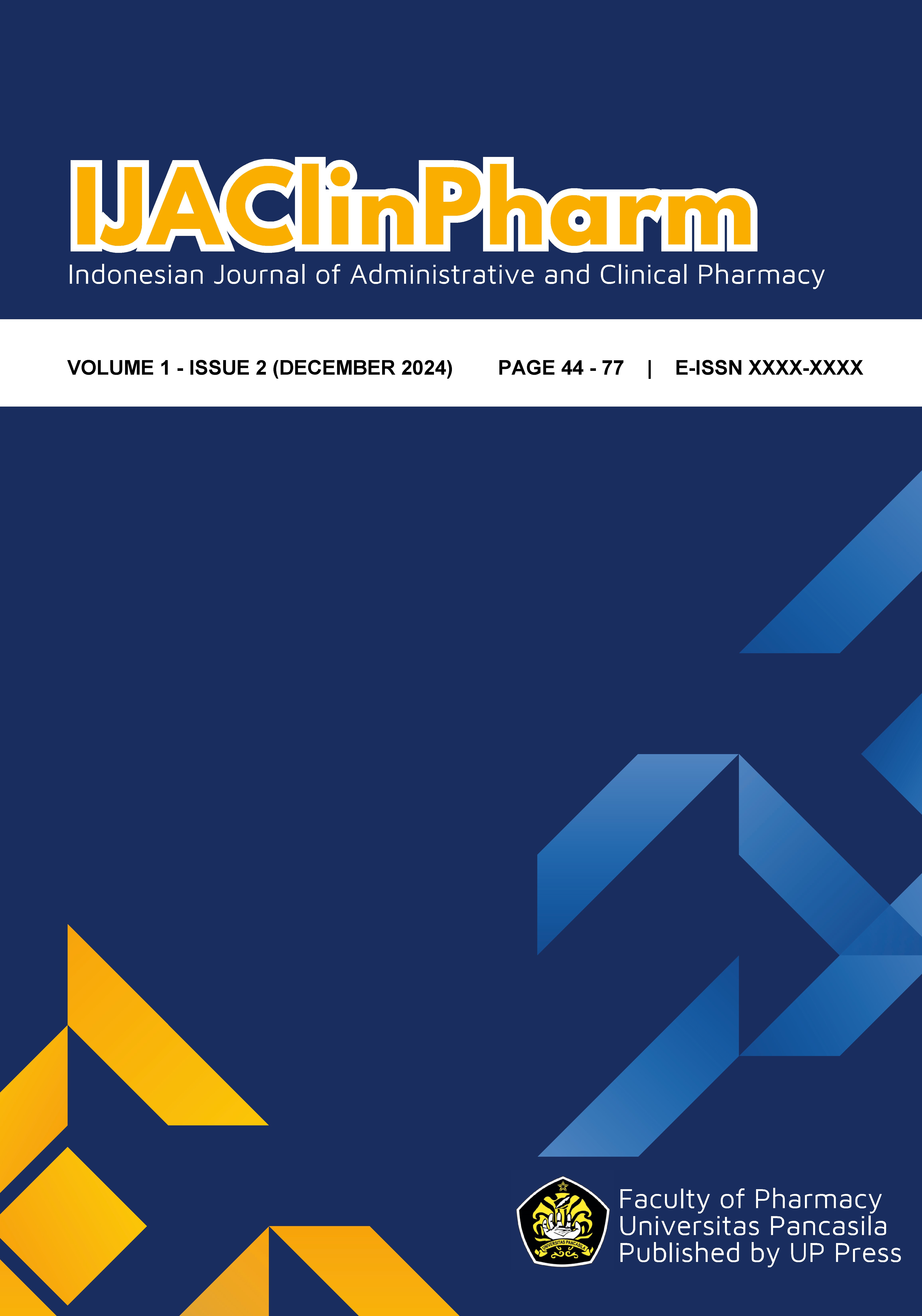Evaluation of High-Alert Medication Storage in the Inpatient Pharmacy Unit of Pasar Rebo Regional General Hospital
Main Article Content
Abstract
High-Alert Medications are medicines that pose a high risk of causing severe errors or adverse events, including sentinel events and unintended drug reactions. These medications including high-risk medicines, concentrated electolytes, and LASA (Look-Alike-Sound-Alike) medicines. This study evaluates the storage practices for high-alert medications at the inpatient pharmacy unit of Pasar Rebo Regional Public Hospital, assessing compliance with the hospital's Standard Operating Procedures (SOP) for such medicines. Data collection was conducted prospectively using an observation checklist aligned with the SOP for high-alert medication storage. The findings showed 100% compliance for concentrated electrolytes, 80% for high-risk medicines, and 83.75% for LASA medicines. High-alert medicines were stored separately from other medicines, marked with red warning tape, and labeled with "High Alert" stickers. However, LASA medicines were not placed in a dedicated cabinet; instead, they were stored at least two shelves apart from other medicines and labeled as "LASA." In conclusion, the storage of high-alert medicines at the inpatient pharmacy unit generally adheres to the SOP but requires improvement, particularly in providing a dedicated storage system for LASA medicines.
Article Details
Section
References
Rusly, Modular Printed Teaching Materials in Pharmacy: Hospital and Clinic Pharmacy, Jakarta: Ministry of Health of the Republic of Indonesia, 2016.
Regulation of the Minister of Health of the Republic of Indonesia No. 72 of 2016 about Pharmaceutical Service Standards in Hospitals. Jakarta; Ministry of Health, 2016.
R. Andriyani and G. A. Gina, “Evaluation of High Alert Medication Storage in the Pharmacy Installation of Hospital X Tangerang,” Edu Masda Journal, vol. 5, no. 2, pp. 56–62, 2021.
E. Purba and P. Sımanjuntak, Research Method, Universitas HKBP Nommensen, Medan, 2011.
A. Hasnawati and A. L. Anita, “Implementation of Medication Storage System in Sidomulyo Inpatient Health Center, Pekanbaru City,” Scientia Journal of Pharmacy and Health, vol. 6, no. 1, pp. 9–10, 2016.
A. Robhi, “Evaluation of Insulin Pen Use in Type II DM Patients in Outpatient Care at RSUP Dr. M. Djamil Padang,” Undergraduate Thesis, Faculty of Pharmacy, Perintis Indonesia University, Padang, 2020, p. 52.
Regulation of the Minister of Health of the Republic of Indonesia No. 5 of 2023 on Narcotics, Psychotropics, and Pharmaceutical Precursors. Jakarta; Ministry of Health, 2023.
D. Haryadi and W. Trisnawati, “Evaluation of High Alert Medication Storage in the Pharmacy Installation of Juanda Hospital, Kuningan,” Jurnal Farmaku, vol. 7, no. 1, pp. 7–13, 2022.
Y. Suhartini and A. Yosita, “Evaluation of LASA Medication Storage in the Pharmacy Installation of Stella Maris Hospital, Makassar,” Yamasi Health Journal, vol. 6, no. 1, pp. 80, 2022.
N. Nurul, “Management of LASA (Look Alike Sound Alike) Medications in Indonesia Using Systematic Review Method,” Undergraduate Thesis, Faculty of Health Sciences, UIN Syarif Hidayatullah, Jakarta, 2021, p. 24.
K. Lailia, “Evaluation of the Compliance of High Alert Medication Storage in the Pharmacy Installation of Citra Husada Hospital,” Undergraduate Thesis, Faculty of Pharmacy, Borneo Cendekia Medika School of Health Sciences, Kalimantan, 2022, pp. 33–47.
M. Muhlis and A. Resa, “Pharmacists’ Knowledge of LASA Medications and Their Management in Pharmacies in Yogyakarta,” Indonesian Journal of Clinical Pharmacy, vol. 8, no. 2, pp. 109, 2019.
N. Rika and E. Wempi, “The Impact of Storage and Labeling of High Alert and LASA Medications on the Risk of Human Error in a Private Hospital in Bandung,” Journal of Science, Technology, and Entrepreneurship, vol. 3, no. 1, pp. 6–7, 2021.
A. Ririn and N. Heru, “Overview of High Alert Medication Storage at RSUD Kardinah Tegal City,” Parapemikir Journal of Pharmaceutical Science, vol. 4, 2020.

